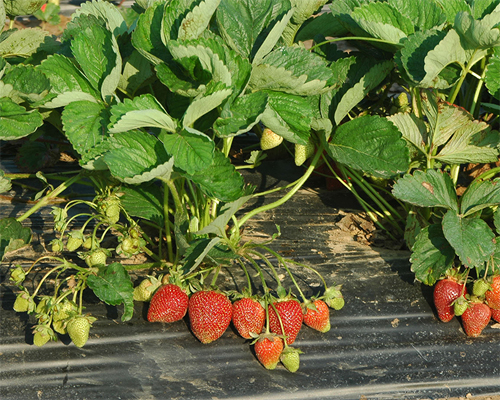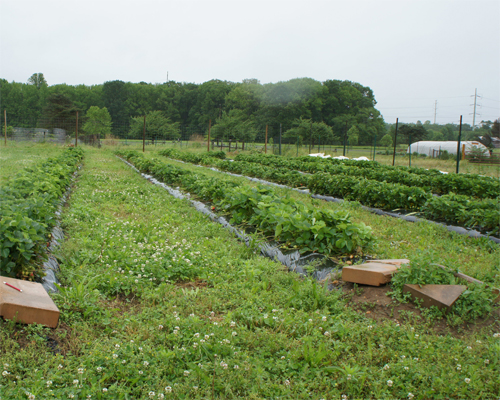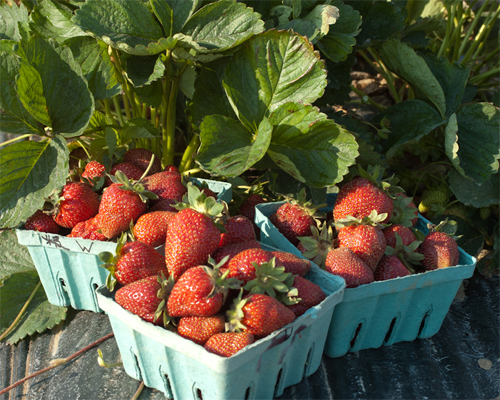
Fact Sheet FS1258
Ultra-Niche Crops are defined as exceptionally high-value crops that can provide a significant source of income to the farmer while using minimal land area.
Direct market sales give small acreage strawberry producers an advantage in providing ripe, high-quality strawberries. Strawberries are known to have a short postharvest shelf life, and the ability to shorten the length of time from harvest to sale increases fruit quality and the amount of time fruit is edible for the customer. Careful handling of fruit from harvest to sale plays a critical role in the overall quality, perishability and safety of the strawberry.
Postharvest Quality and Handling
Should workers be trained on how to harvest strawberries? Farm workers who harvest the fruit play a key role in the quality of the strawberries. Employees must be trained on how to properly handle, grade, and pack the strawberries. An employee who is uneducated or unhappy with their work can have drastic implications on the product they harvest, and ultimately your sales revenue. Hand harvesting by gently pulling the fruit from the stem should be explained and demonstrated to employees.
How often should the strawberries be harvested? Timing of harvests should coincide with ripeness of the crop and sales opportunities. Harvesting should take place frequently to avoid picking over-mature fruit. Will the fruit ripen and flavor improve after it has been harvested? Strawberries can color up a bit after harvest, but fruit flavor will not improve in the postharvest period.
What temperature should strawberries be stored at? The optimal storage temperature for strawberries is 32°F. Strawberries will begin to freeze at 30.6°F. It is important to place harvested strawberries into cooler temperatures as quickly as possible. This can include initial movement to a shaded area and frequent trips to the cooler. Once the berry is removed from the vine it will rapidly increase in temperature if left in the heat and sun. Ideally, strawberries should be in a cooled environment within an hour from harvest. Once in the cooler, the flats may be spread out to encourage more rapid temperature reduction. Forced air cooling is an effective rapid cooling method for strawberries. Botrytis is the most common postharvest disease that affects strawberries. Its growth is reduced by maintaining the cold chain.
What relative humidity should strawberries be kept at in the cooler? The ideal relative humidity is between 90 to 95%. This can be difficult to achieve in a cooler without other harvested crops occupying the space. Covering the berries with a non-sealed covering or wetting the floor are options of increasing the relative humidity. Selecting containers like clam-shells with covers that are vented may aid in reducing moisture loss.
How should strawberries be handled when transported to a sales location? Strawberries should be fully cooled before they are transported for sale and kept under refrigeration while in transit. Berries should be carefully loaded and stacked so that the fruits do not become damaged by crushing or frequent movement in the vehicle. The cold chain should be maintained at all times; proper cold chain management can increase the market life of strawberries by seven or more days. Without refrigeration, strawberries can become unmarketable within days of harvest.
When selling at a farm stand or market how should berries be stored? Strawberries should be kept in a refrigerated case or cooler prior to sale, as close to 32°F as possible, but not below this temperature. Keeping strawberries cooled will help lengthen the life of the berry before it becomes inedible. One method of achieving this is to have display berries while berries to be sold are stored in a refrigerated sales case or a travel cooler.
Food Safety Considerations
Do I have to worry about food safety issues with strawberries? Strawberries have an elevated risk of contamination from human pathogens due to growing close to the ground. Strawberries are also commonly consumed without cooking. Consideration should be given to the risk for contamination of strawberries within your production system. Each farm operation is unique, and the food safety considerations must be specific to the location, employees, field operations, and postharvest operations of a farm.
Are there water quality standards specific to irrigation for strawberries? Contaminated irrigation water that comes in contact with strawberries will contaminate the fruit. Ideally, for both plant disease and human disease, irrigation of strawberries should be done through drip tape. Contaminated overhead irrigation water can spread both plant and human diseases throughout a crop. Strawberries have a rough surface that makes it difficult to sanitize if it has become contaminated. Irrigation water should be tested to better understand its overall quality and how it is impacted by weather events. This is particularly true for surface irrigation water, such as ponds and streams.
Can I use compost with animal manures in strawberry production? Animal manures can carry human diseases in them, such as E. coli, Listeria and Salmonella. It is important that composts using animal manures as an ingredient are composted appropriately before they are applied to fields. Currently the National Organic Program Standards are accepted by the USDA and the FDA.
What should I do if I find that wildlife has entered the strawberry field? Developing an action plan to be used when fecal material or wildlife feeding on crops occurs is important. It is recommended that fields are scouted for animal activity prior to harvesting. Any areas where fecal material or evidence of feeding are found should be taped off so that harvesting does not take place there. A five foot buffer around fecal material is recommended. Once this plan is developed all workers should be aware so that proper action is taken.
Can farm workers contaminate strawberries? Strawberries are commonly harvested by hand, and the health of the harvester is critical. Workers coming in contact with produce and its growing area should receive annual training on human health and hygiene specific to fresh produce safety. This annual training should focus on human diseases communicable to others, the routes of contamination, proper handwashing, proper restroom use and food safety policies specific to the farm. More information on this type of training can be found in Rutgers fact sheet FS1230, "Worker Health and Hygiene".
Do I need to worry about using sales containers more than once? Packing materials, such as clamshells, paper boxes, etc. can serve as a source of contamination if they are not handled and stored properly. Re-using containers is possible. Do the containers look clean? Do the containers smell clean? Do you know where the containers have been used and stored? All of these questions can help you determine if a container is acceptable for re-use. Appropriate storage areas for containers are areas that have a rodent control program, are free from other wildlife and pets, and free of physical contaminants.
Critical Suggested Considerations
- Temperature management is the most critical aspect of prolonging postharvest quality for strawberries. Picked berries should be removed from sun and heat as soon as possible.
- Attend an on-farm food safety training to better understand food safety risks and modes of contamination.
- Conduct risk assessments for your operation focusing on: land-use history, water system and movement, animal activity (wildlife and domestic), soil amendments used and made, packing house area, and produce distribution methods.
- Develop written instructions (standard operating procedures SOPs) for activities deemed high risk, such as procedures for washing product contact surfaces. These SOPs will streamline processes at the farm and ultimately reduce the risk of product contamination.
- Train workers annually on worker personal health and hygiene and the identified risks on the farm.
- Sample irrigation and postharvest water as deemed necessary.
References
Additional Information
September 2016
Copyright © 2024 Rutgers, The State University of New Jersey. All rights reserved.
For more information: njaes.rutgers.edu.
Cooperating Agencies: Rutgers, The State University of New Jersey, U.S. Department of Agriculture, and Boards of County Commissioners. Rutgers Cooperative Extension, a unit of the Rutgers New Jersey Agricultural Experiment Station, is an equal opportunity program provider and employer.




 Project sponsored by the USDA-NIFA Beginner Farmer and Rancher Development Program.
Project sponsored by the USDA-NIFA Beginner Farmer and Rancher Development Program.